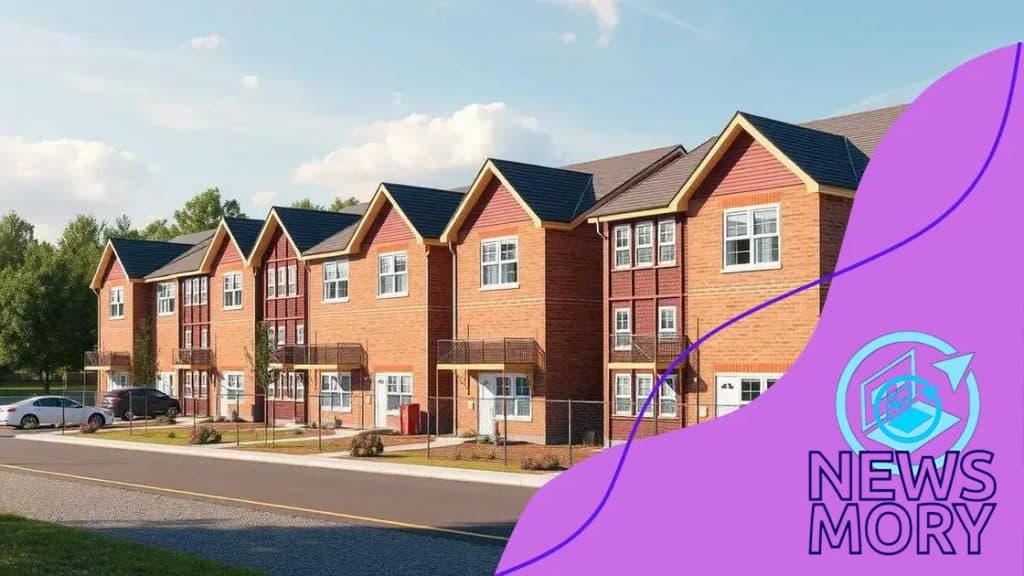Federal programs supporting affordable housing development

Anúncios
Federal programs supporting affordable housing development provide essential financial resources and innovative strategies to enhance access to safe and affordable homes for low-income families and communities.
Federal programs supporting affordable housing development are essential for creating safe, affordable living options in communities nationwide. Have you wondered how these initiatives can impact your neighborhood?
Anúncios
Overview of federal programs for housing
Understanding the federal programs for housing is essential for anyone interested in affordable living solutions. These programs are designed to assist communities in addressing their housing needs and improving the quality of life.
Types of Federal Housing Programs
There are several types of federal programs available to support housing development. Each plays a unique role in helping individuals and communities.
- Community Development Block Grants (CDBG): These grants are allocated to local governments to improve various aspects of community living.
- Low Income Housing Tax Credit (LIHTC): This program provides incentives for the construction and rehabilitation of affordable rental housing.
- HOME Investment Partnerships Program: HOME helps create affordable housing for low-income families through grants to states and localities.
- Section 8 Housing Choice Vouchers: This program assists very low-income families in obtaining stable, affordable housing in the private market.
Additionally, federal programs often collaborate with state and local governments to create a more comprehensive approach to housing assistance. For instance, programs like the Affordable Housing Program (AHP) are tailored to enhance community needs and fund specific projects for better housing availability.
Anúncios
Impact on Communities
The impact these programs have on communities can be profound. They not only help build housing but also foster social and economic development. By securing funding, communities can address issues such as homelessness, improve infrastructure, and enhance local economies.
Furthermore, engaging with these programs can lead to the development of supportive services, including education and job training, which is vital for residents’ success.
Overall, exploring federal programs for housing reveals a network of support designed to uplift communities and provide essential resources for affordable living options.
Key benefits of affordable housing initiatives
Exploring the key benefits of affordable housing initiatives reveals how these programs can positively impact communities and individuals. These initiatives are crucial for enhancing the quality of life.
Improved Economic Stability
One major benefit is increased economic stability for families. By reducing housing costs, families can allocate more resources towards other essential needs, such as education and healthcare. This stability also strengthens local economies by allowing residents to spend more within their communities.
- Job creation: Affordable housing initiatives often lead to construction projects that generate local jobs.
- Increased property values: Well-planned housing can uplift neighborhoods, enhancing property values.
- Support for local businesses: More residents in an area leads to increased demand for goods and services.
Moreover, these initiatives play a significant role in reducing homelessness. With adequate support and resources, communities can provide housing for those in need, helping to create a more inclusive society. When individuals have access to stable housing, they are more likely to find employment and contribute positively to society.
Enhanced Community Well-Being
Affordable housing also leads to improved community well-being. When people live in safe and affordable homes, their overall health and mental well-being improve. Affordable housing initiatives often include access to supportive services, such as mental health resources and financial counseling.
Additionally, these programs foster social cohesion by bringing people together in diverse communities. Residents are more likely to engage with one another, building friendships and networks that enhance community strength. When members of a community coalesce, it creates a vibrant environment conducive to collaboration and support.
In summary, the key benefits of affordable housing initiatives extend far beyond just providing shelter. They bolster economic stability, promote well-being, and cultivate strong communities.
Eligibility criteria for funding programs

Understanding the eligibility criteria for funding programs is vital for anyone seeking assistance with affordable housing development. Each program has its own specific requirements that applicants must meet to qualify for support.
General Requirements
Most funding programs have basic requirements. For instance, applicants often need to demonstrate financial need. This can be shown through income statements or tax returns. Generally, eligibility also includes:
- Low-to-moderate income: Many programs are aimed at those whose income falls below a certain threshold.
- Residency status: Applicants usually need to be U.S. citizens or have legal residency to qualify for many federal programs.
- Creditworthiness: Some programs may require a minimum credit score or a history of responsible financial behavior.
In addition to these general criteria, specific programs may have unique requirements tailored to their goals. For instance, programs focused on veterans often prioritize housing for individuals who served in the military.
Documentation Needed
Applicants will typically need to provide several documents as part of their application. These may include proof of income, identification, and information about current housing situations. Keeping these documents organized can streamline the application process and help ensure eligibility.
Moreover, often local or state agencies administer these programs, meaning eligibility may vary slightly by region. Therefore, it is essential for applicants to check with local housing authorities or website resources for specific details related to their area.
Ultimately, being aware of the eligibility criteria for funding programs can save time and enhance the chances of securing necessary support in affordable housing initiatives.
Successful case studies of housing development
Examining successful case studies of housing development provides valuable insights into the effectiveness of various affordable housing initiatives. These examples highlight the strategies and partnerships that lead to significant positive outcomes.
Case Study 1: The Affordable Housing Initiative in Austin
Austin, Texas, has implemented a well-regarded affordable housing initiative aimed at creating more housing options for low-income families. This program has successfully developed several mixed-income communities, integrating affordable units with market-rate housing. The result has been a more diverse neighborhood with improved access to resources and services.
- Community engagement: Residents were involved in the planning process, ensuring their needs were met.
- Smart growth principles: The development focused on walkability, public transport access, and green spaces.
- Partnerships: Collaboration with local nonprofits helped secure funding and support for the project.
Overall, this case study demonstrates how inclusive planning and community involvement can lead to successful housing developments.
Case Study 2: The Bronx’s Reinvestment Project
In New York City’s Bronx, a reinvestment project focused on rehabilitating existing buildings turned underutilized spaces into affordable housing units. This project not only created hundreds of affordable homes but also improved the overall neighborhood environment.
Key features included the integration of sustainable building practices, which reduced utility costs for residents. By revitalizing dilapidated structures, the project enhanced community pride and stability. The emphasis on local hiring during construction also contributed to job creation within the community, showcasing the project’s holistic approach.
These successful case studies of housing development illustrate the potential for positive change through strategic planning, community participation, and sustainable practices. They serve as models for other cities aiming to tackle affordable housing challenges effectively.
Future trends in affordable housing support
Understanding the future trends in affordable housing support is essential for stakeholders involved in housing development. As the needs of communities evolve, so do the strategies to support affordable housing initiatives.
Increased Use of Technology
One major trend is the increased use of technology to enhance housing development processes. Innovations like building information modeling (BIM), drones, and 3D printing are making construction faster and more efficient. Technology also helps in project management and tracking funding allocations.
- Smart homes: Incorporating smart technology in housing can improve energy efficiency and reduce costs.
- Data analytics: This helps developers understand housing needs better and assess market trends.
- Online platforms: Websites and apps simplify application processes for funding and housing programs.
Furthermore, technology enables better communication between housing authorities and residents, ensuring that community needs are met more effectively.
Focus on Sustainable Practices
Sustainability is becoming a cornerstone of affordable housing projects. Developers and policymakers are increasingly emphasizing environmentally friendly building practices. This includes using renewable materials, enhancing energy efficiency, and creating green spaces.
Many programs are looking to integrate sustainability into their funding criteria to encourage eco-friendly projects. For instance, projects that utilize solar power significantly reduce energy costs for residents, making housing more affordable in the long run.
The shift toward sustainability is not just beneficial for the environment; it also attracts a younger demographic that prioritizes eco-conscious living. Ultimately, this trend shapes the future of affordable housing support in meaningful ways.
As we look ahead, the future trends in affordable housing support indicate a promising shift towards incorporating technology and sustainability, paving the way for more effective solutions in the quest for affordable living options.
Affordable housing initiatives are crucial for building strong communities and improving lives. As we move forward, understanding the latest trends, such as technology and sustainability, will help us create smarter, greener, and more inclusive living spaces. By focusing on these key areas, we can better address the challenges of affordable housing and ensure that everyone has access to a safe and affordable home.
FAQ – Frequently Asked Questions about Affordable Housing Development
What are the main benefits of affordable housing initiatives?
Affordable housing initiatives provide economic stability for families, reduce homelessness, and create vibrant communities by ensuring access to safe housing.
How can technology improve affordable housing development?
Technology can streamline the construction process, enhance project management, and create smart homes that reduce energy costs for residents.
What are the eligibility criteria for funding programs?
Eligibility usually involves income requirements, residency status, and sometimes a minimum credit score. Specific criteria can vary by program.
Why is community engagement important in housing projects?
Community engagement ensures that the needs and desires of residents are taken into account, leading to better planning and more successful housing developments.





